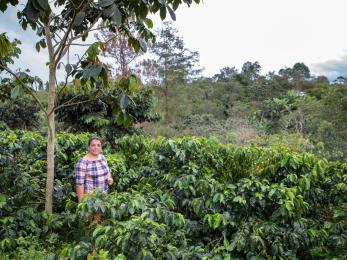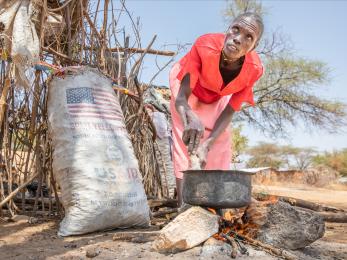Where climate change drives conflict, peacebuilding skills are the path forward
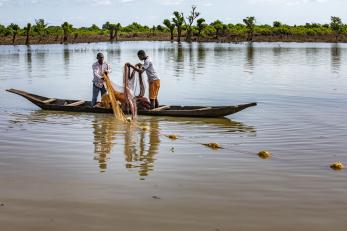
In communities where climate change is depleting life-giving resources, increasing tension and pushing families to the brink, we’re empowering them to fight back. Our peacebuilding work bridges divides and improves conflict-management skills so vulnerable people are equipped to build resilience to the climate crisis — by facing it together.
Read how this work is transforming communities in Nigeria below.
Perched on the edge of a narrow, wooden fishing boat pulled high on the shore, Moses scans the hum of activity on the river beside him: children running along the muddy bank, their bare feet clapping against the sun-baked ground; women quietly bathing; girls knee-deep in the water, washing dishes from their families’ last meal; young men in modest fishing boats, gracefully rowing to and from shore.
In this village in Nigeria’s Middle Belt region, where many people rely on different forms of agriculture to survive, this river is a source of life for nearly everyone, providing income and water for families who fish, grow crops and raise animals to support themselves.
As a fisherman, Moses depends on the river to provide for his wife and children; it’s how he has earned food and income for almost 40 years, taking to the water for several hours every day.
But the water has been low and inconsistent for the better part of a decade, Moses says, gazing at the river, its shallow current exposing a wide expanse of dry, craggy bank on either side. And his fishing livelihood has become increasingly unreliable.
“I don’t earn enough money [now], so feeding my family has been difficult,” he explains.
As the effects of climate change play out globally in more extreme weather and diminishing natural resources like this, it’s people like Moses — those whose survival is already fragile and inextricably linked to land and water — who are hit hardest.
Across communities like his, families are being forced to survive with less, a change not only creating unprecedented challenges earning income and food, but also putting desperate families at odds with one another — and creating environments ripe for potential conflict.
How climate change pummels people in poverty
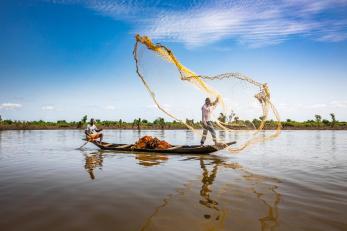
“I understand the unpredictability of my livelihood,” Moses says. “I think about [giving up] all the time.”
But in Nigeria, a country where two-thirds of the labor force is employed by agriculture and around half the population lives on less that $2 per day, the margin for coping — let alone seeking new opportunities — is slim.
Three out of four people living in poverty globally rely on agriculture and natural resources to survive, so the effects of climate change — shifts in weather patterns, soil quality, availability of water or natural disasters — can be especially catastrophic for these populations.
The Intergovernmental Panel on Climate Change reports 500 million people were already living in areas turning from fertile land into desert in 2015, most believed to be in South and East Asia, North Africa and the Middle East. Land degradation is currently occurring in a quarter of the world’s ice-free land, affecting billions of people, the majority of whom live in poverty in developing countries.
And as natural resources like water, pasture and farmable land become harder to access for those whose livelihoods depend on them, the competition over remaining resources rises in parallel, creating pressure that can and does erupt into violence.
The relationship between climate change and conflict
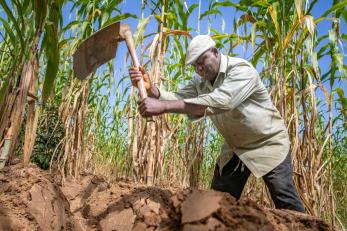
In Nigeria’s Middle Belt, decades-old tension between farmers and pastoralists, largely over competition for natural resources, has flared into violence as population growth and climate change have made land and water more scarce in recent years.
The conflict has displaced hundreds of thousands of people and cost the Nigerian economy billions. Last year, attacks between farmers and pastoralists were so deadly they killed more people than Boko Haram.
“I was very sad, because many people were disposed [killed],” says Abubakar, a farmer whose own Middle Belt community spiraled into violence several years ago as farmers and pastoralists, at odds about land use, engaged in assaults, retaliatory attacks and destruction of each other’s property.
“A lot of people could not afford three square meals, and it made them engage in illicit activities,” he says.
Abubakar’s crops — acres of maize, cassava, groundnuts, rice, yam and millet — were completely destroyed during that tense time, forcing him to give up farming and, having lost his source of income to pay fees, take his children out of school.
The clashes have calmed since then, enabling Abubakar to recover some of his livelihood — but only enough that everything he earns goes toward food for his family. And the area’s available land still isn’t enough to meet all the farmers’ and pastoralists’ needs, so the threat of that stress turning into violence again is ever-present.
“I feel very sad and discouraged,” Abubakar says of the issue.
Climate is estimated to have influenced between 3 and 20 percent of armed conflict risk over the past century and, at the world’s current rate of warming, its influence could increase more than five times.
As the global community works to address the threats of climate change and build a more sustainable future, it’s critical we also protect the people around the world who are already experiencing its dangers firsthand, including lost livelihoods, less food and heightened risk of insecurity.
Confronting the human toll of climate change
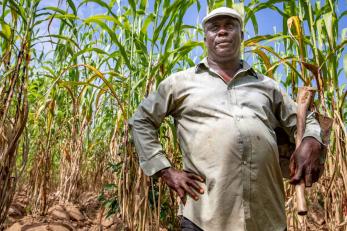
In communities like Moses’s and Abubakar’s, where resources are stretched to the brink and resulting hostility is high, Mercy Corps is implementing peacebuilding work to help people adapt and stay safe in increasingly-volatile environments.
These projects — including conflict-management trainings, community peace committees and dialogue sessions, in which opposing parties can learn from one another — offer community members an opportunity to build the skills, trust and community cohesion necessary to maintain peace and create stable lives against the backdrop of climate change.
“Peacebuilding is not just about dealing with violence,” says Tog Gang, a Mercy Corps team member who works on peacebuilding in Nigeria. “It’s about addressing all those underlying issues that led to the fragility, conflict or violence in the first instance.
“We are providing tools for local leaders or local communities to ensure that there is not a recurrence of violence.”
In Middle Belt communities where this work was implemented, our research found that trust and contact between farmers and pastoralists improved or stayed the same, even while regional tensions increased. And the benefits, such as trust and perceived security, extended past the individual participants into to the wider community.
“I have seen the good work Mercy Corps is doing out here and I am hoping it will restore our community back to normalcy,” Abubakar says. “I have seen [a change]. There has been less conflict between farmers and herdsmen.”
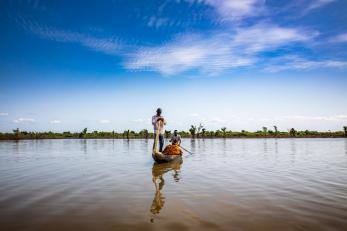
In his village where, similarly, fishermen, pastoralists and farmers must all share the limited water the river provides, Moses has experienced a change too. He participated in a dialogue session and a training that taught community members how to recognise conflict and how it escalates, and how to peacefully work through it.
He says unity was once a hard concept for people in his community to believe in, but having an opportunity to interact with other groups, like in the dialogue session, can breed tolerance and reduce conflicts. Since attending the conflict-management training, he has successfully mediated disagreements between others in his community.
“The training taught me an important thing,” he says. “It taught me the importance of peace.”
Even though the climate challenges in his community remain a persistent threat, that he and others are now empowered with the ability to overcome them, together, is an important step toward thriving. And Moses is optimistic about the future.
“We will live in peace,” he says.

